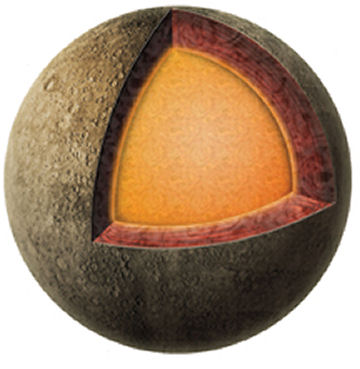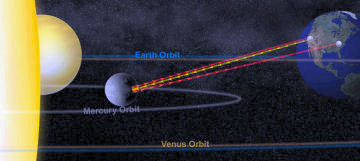Liquid Mercury
Our solar system's innermost planet has a molten core.
By Emily Sohn
Mercury is the least studied planet in our solar system, and scientists continue to debate some basic facts about the small body. One lingering question is whether Mercury has a liquid core. New research now suggests that it does.
The closest planet to the center of the solar system, Mercury is about one third as far from the sun as Earth is. Since Earth has a liquid core, and since Mercury receives more of the sun’s heat than Earth does, it would seem likely that Mercury’s core would also be molten.
 |
|
Scientists have been wondering since at least 1974 whether Mercury has a liquid core. It turns out that the planet does.
|
| Nicolle Ragger Fuller/National Science Foundation |
It turns out, however, that the consistency of a planet’s core doesn’t depend primarily on heat from an outside source. Rather, heat left over from the formation of the planet determines whether it will still be liquid on the inside. Since Mercury is small—just 40 percent as wide as Earth—it should have cooled long ago. In that case, Mercury’s core would be solid.
The debate about Mercury’s core began in 1974, when the Mariner 10 spacecraft detected a magnetic field around Mercury. Rocky planets such as Earth can have magnetic fields when charged materials inside their liquid cores slosh around. The fact that Mercury has a magnetic field, therefore, suggests that there is liquid inside.
But some scientists offered another explanation for the magnetic field. It’s possible, they reasoned, that when Mercury’s core became solid, the magnetic field was frozen in place.
To settle the debate, researchers from Cornell University and the University of California, Santa Barbara and their colleagues studied Mercury’s spin. The planet orbits the sun once every 88 days. And for every two 88-day revolutions, Mercury twirls around on its axis three times. In other words, it experiences three days every two years.
Slight variations in this spinning pattern occur as a result of the sun’s gravity. And the sun’s gravity affects a planet’s spin more if the planet has some liquid in its core.
After bouncing radio waves off of the planet for 6 years, the scientists found a relatively large amount of variation in its spin. There was, in fact, about twice as much variation as they would expect if the planet were solid.
 |
|
Scientists bounced radio waves off of Mercury to measure variations in its rate of spin. Large variations revealed that the planet has a molten core.
|
| Bill Saxton, NRAO/AUI/NSF |
The best explanation for these data, the researchers say, is that there is at least some liquid inside Mercury—either in the core or in the space between the core and the planet’s outer layers.
“It is clear that Mercury is not solid throughout,” says planetary scientist David Stevenson of the California Institute of Technology in Pasadena.
Mercury’s core is made mostly of iron. One theory for why it has remained liquid proposes that there is sulfur inside the planet as well. Sulfur melts at a lower temperature than iron does.
If this theory is correct, other planets might also have incorporated sulfur and other materials that formed far from the planets’ orbits. That would alter theories about how planets formed in our solar system.
More information will arrive next year, when NASA’s MESSENGER spacecraft, which goes into orbit around Mercury in 2011, first flies past the planet. A Japanese-European mission, scheduled to arrive at the planet in 2019, should also help round out the picture.—Emily Sohn
Going Deeper:
Cowen, Ron. 2007. Liquid center: Mercury has a molten core, radar reveals. Science News 171(May 5):277-278. Available at http://www.sciencenews.org/articles/20070505/fob5.asp .
Sohn, Emily. 2006. Saturn’s strangely warm moon. Science News for Kids (April 19). Available at http://www.sciencenewsforkids.org/articles/20060419/Feature1.asp .
______. 2003. A planet’s slim-fast plan. Science News for Kids (March 19). Available at http://www.sciencenewsforkids.org/articles/20030319/Note2.asp .







